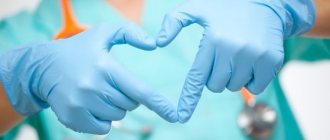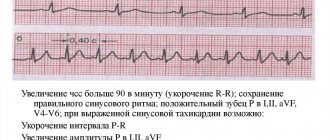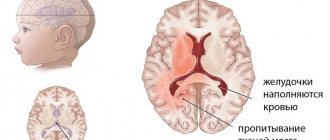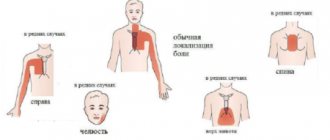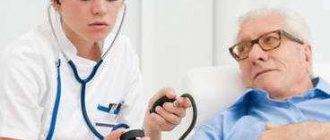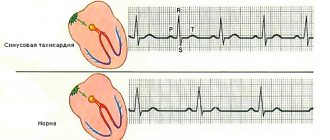- Types of tachycardia in newborns
- Causes
- Symptoms
- First aid
- Possible complications and consequences of the disease
- Who should I contact?
- Diagnostics
- Treatment with traditional methods
- Folk remedies
- Prevention measures
- Tachycardia in children (video)
A child's body is different from an adult's, and the heart rate of a newborn baby may be slightly increased. This is considered one of the normal options. The baby’s body requires more oxygen, its metabolic process also occurs more actively, and therefore the level of heart rate increases.
What happens in the child's body?
Tachycardia is a rapid heartbeat.
For adults, the normal heart rate is 80 beats per minute. Due to the higher speed of metabolic processes occurring in his body, a baby has a pulse of up to 140 beats. A heart rate over 170 can be considered abnormal for him. For various reasons, a child’s pulse may increase, and this does not always indicate pathology. Remember yourself - fear, physical activity, violent emotion - and your pulse quickens. You calmed down and everything went away. And the baby also reacts to some external stimuli - swaddling, examination by a doctor, loud sound, and so on. Such outbursts should not frighten parents.
The situation is much more serious if the attack is accompanied by additional symptoms and lasts longer than a few minutes. Tachycardia in newborns is divided into two types - sinus and paroxysmal. Sinus tachycardia is considered a functional disorder caused by a malfunction of certain body systems. Paroxysmal tachycardia is a more dangerous pathology because it is usually associated with organic damage to the heart.
Characteristics of fetal arrhythmias
Fetal arrhythmia occurs in 1–2% of pregnancies. This heart rhythm disturbance is caused by various pathologies.
The following types of fetal arrhythmia are distinguished:
They, in turn, are divided into malignant and benign arrhythmias, depending on the course of the disease. Benign arrhythmia differs from malignant arrhythmia in the absence of structural abnormalities of the heart.
Fetal bradycardia is characterized by systemic manifestations and cardiac lesions. Often the disease is accompanied by heart disease, heart block or cardiomyopathic syndrome.
Fetal (paroxysmal) tachycardia is a sharp increase in heart rate that can last from several minutes to several hours. On the ECG, tachycardia has quite specific signs. The disease can occur in utero.
During diagnosis, it is impossible to detect an abnormal heart rhythm, so specialists monitor the child’s behavior. Paroxysmal tachycardia is conventionally divided into supraventricular and ventricular types.
Often with fetal arrhythmia, atrial flutter, atrial septal defect and patent atrioventricular canal are detected in the fetus.
With paroxysmal tachycardia, a sharp increase in heart rate of up to 200 beats per minute or more often occurs. If attacks are frequent and prolonged, they easily provoke heart failure. The fetus may experience cerebral complications and impaired blood supply to the brain.
The duration of the tachycardia period depends on many factors, so it varies from 30 seconds to a week
How to act
There is no need to regularly check your child's pulse. Moreover, you should not use tonometers (pressure measuring devices) designed for adults with a large cuff for this purpose.
When registering tachycardia on an ECG, you must show this ECG to the doctor who referred you for the study (pediatrician or cardiologist). Since tachycardia is not a disease, its identification requires a medical examination, and, if necessary, additional research to identify the cause of the accelerated heartbeat.
When to see a doctor and how often to get checked
If the child is feeling well and is developing normally, periodic palpitations are not a cause for concern. You should consult a doctor if you experience:
- high body temperature, headache;
- dry skin and retraction of the fontanel in infants;
- shortness of breath, chest pain, difficulty breathing;
- interruptions in heart function, dizziness or fainting;
- weakness, deterioration in school performance, pale skin and mucous membranes, drowsiness, swelling of the face or legs.
The first way to detect tachycardia in a child is electrocardiography. With sinus tachycardia, the following ECG signs are noted:
- increase in heart rate per minute compared to the age norm;
- all teeth are present;
- the RR interval is shortened due to the shortening of the diastolic pause - the TP segment.
With supraventricular paroxysmal tachycardias, the P wave is negative or not detected at all on the ECG. Ventricular tachycardia is manifested by regular widened QRS complexes without connection with P waves. An experienced functional diagnostics doctor will easily make a differential diagnosis between these conditions.
ECG in children with normal health and absence of heart murmurs is recorded during medical examinations at the age of 1 year, 6 years, 15 and 17 years. The doctor will refer you for a cardiogram if you have complaints of pain in the chest, shortness of breath, cyanosis of the nasolabial triangle, exercise intolerance, or if a heart murmur is detected.
If tachycardia is registered, the child may be prescribed 24-hour ECG monitoring. This study will provide information on the average daily, average night and average daily heart rate, compliance with age standards, rhythm disturbances, duration of the QT interval and other indicators.
If persistent tachycardia occurs, echocardiography (ultrasound of the heart) is prescribed. It provides information about the structural condition of the heart, such as minor malformations (patent foramen ovale) or congenital defects.
Diagnostics
When the first symptoms of the disease appear, you should consult a pediatrician. He will conduct a thorough survey and examination of the child, and then refer him for additional research.
Clinical diagnostic methods are:
- Survey. During the survey, the doctor asks the parents for information about the symptoms that are bothering the newborn child, the time of onset and frequency of the disease. The presence of chronic diseases and the child's taking any medications are of important diagnostic significance. Older children independently complain of dizziness, darkening of the eyes, palpitations, and shortness of breath.
- Inspection. During the examination, the doctor assesses the general condition of the child, the color of his skin, and motor activity. Performs simple diagnostic methods - cardiac auscultation, heart rate determination, pulse oximetry.
Next, additional diagnostic methods are prescribed, which include laboratory tests and instrumental studies:
- Clinical and biochemical blood tests - allows you to identify the inflammatory process, anemia and other concomitant pathologies;
- A blood test for the level of thyroid hormones is prescribed to diagnose thyroid pathology;
- ECG - allows you to evaluate the heart rhythm in children over 3 years old (at a younger age it is rarely possible to conduct the study correctly).
- Holter monitoring – recording an ECG for 24 hours, which is carried out to identify the connection of tachycardia with physical, emotional stress and other factors; in addition, the study allows you to evaluate the continuous work of the heart during the day;
- Ultrasound of the heart is an instrumental study that allows you to diagnose structural changes in the organ;
- Electroencephalography is a study of the electrical activity of the brain (carried out to assess the functioning of the central nervous system).
Drugs for the treatment of tachycardia in children
Any type of pathology under consideration should not be deprived of the attention of medical specialists. Any changes in condition can cause extremely negative consequences
Therefore, the health of the baby depends entirely on the timeliness of visiting doctors.
In the case of sinus tachycardia, there may be no need for special therapy. Often it is enough to plan the daily routine, perhaps change the climate, bring the nervous system to a state of rest.
Paroxysmal tachycardia in a newborn must be treated without fail. At the same time, the most common drugs prescribed by doctors to children suffering from this disease are Amiodarone, Digoxin and Izolanide. In simple cases, Novocaine is prescribed in combination with sodium bromide and magnesium sulfate. If such a complex does not give the desired result, it is advisable to use Novocainamide.
Symptoms
During an attack of paroxysmal tachycardia, a child experiences a sharp increase in heart rate. In one minute, the number of heart contractions can reach 200 beats. The attack itself is felt by the baby as a sharp blow to the chest. This may cause a feeling of tightness in the chest area. The patient becomes lethargic and pale. Often an attack of tachycardia is accompanied by vomiting and excessive urination.
Due to the inexpressive symptoms of the disease, it is quite difficult to diagnose it. It is especially difficult to identify the beginning and end of an attack, since in newborn children any anxiety increases the heart rate.
Paroxysmal tachycardia can be detected when there is a severe disturbance of the heart rhythm against the background of normal body temperature. During an attack, the child may experience severe convulsions. At the same time, the baby’s gaze and consciousness remain clear.
Prevention measures
The prognosis for this disease is favorable in most cases. By getting rid of the cause that causes tachycardia, it is possible to stabilize the heart rate of a newborn baby.
You can maintain heart health with moderate physical activity, proper exercise and nutrition. The baby should not experience strong emotional shocks. A newborn baby should not be overheated or hypothermic, and the risk of contracting viral infections should be avoided.
To prevent a child from getting sick, you need to harden him and strengthen his immune system, and conduct preventive medical examinations. If you suspect tachycardia, your baby should be shown to a doctor as soon as possible, and not try to get rid of it on your own.
Treatment of pathology
Emergency help
During an attack, you must follow these recommendations:
- let fresh air into the room;
- cover the child's forehead with a cold towel;
- contact a specialist.
If tachycardia is of the paroxysmal type, then first aid depends on the location of the origin of the abnormal impulse. For the supraventricular form, the following steps must be taken:
To alleviate his condition, the baby should push with his nose closed.
- Child 3-4 years old: close the baby’s nose and ask him to push;
- massage the carotid artery.
- press on the root of the tongue;
If an attack of the ventricular form occurs, then help is provided with drugs:
- Intravenous administration of "Lidocaine 1%" approximately 1-1.5 mg/kg.
- If the attack does not subside, then you need to administer a solution of Gilurythmal 2.5%, diluted with 10-20 ml of sodium chloride 0.9% in an amount of 1 mg/kg.
- If the attack continues, Amiodarone 5% diluted with glucose 5% is administered - 10 ml.
Medicines
Treatment of tachycardia in children with medication is carried out only as prescribed by a doctor, who can adjust the dosage and course of therapy depending on the patient’s condition. Frequently prescribed drugs are presented in the table:
| Group | Drugs |
| Sedatives | "Seduxen" |
| "Luminal" | |
| "Valerian" | |
| "Asparkam" | |
| Potassium-containing | |
| Cardiac glycosides | "Digoxin" |
| "Verapamil" | |
| Beta blockers | "Pindolol" |
Surgery
Sometimes a patient's problem can be solved with the help of a pacemaker.
If other treatment options have not brought positive results, the attending physician may decide to perform surgery. Surgical procedures for tachycardia:
- Radiofrequency ablation. The method is based on the destruction of areas that supply the wrong impulse.
- Introduction of a pacemaker. An artificial pacemaker maintains the correct heart rate.
- Heart valve surgery. The operation is performed if there are certain congenital abnormalities.
Healers' recipes
Mild sinus tachycardia is treated with alternative medicine methods. Any influences can be carried out only after consultation with a specialist. Effective recipes:
- Motherwort infusion. One tbsp. l. dry herbs should be steamed with 1 cup of boiling water and left for 60 minutes. Strain the mixture, add 3 drops of peppermint oil, 1 tsp. honey The composition must be mixed and drunk. The course of therapy is 30 days.
- Valerian root decoction. Two tsp. The root is mixed with 1 teaspoon of dry dill, lemon balm, and hop cones. The mixture is poured with 350 ml of boiling water and left for half an hour. Drink 200 ml of the decoction before meals.
- Herbal collection. Mix 10 grams of horsetail, motherwort and hawthorn and add 0.5 liters of water. The mixture is heated in a water bath for 20 minutes and then cooled for 50 minutes. The strained tincture is taken 50 ml 4 times a day.
Features of the course of pathology in childhood
Like other diseases, tachycardia depends not only on the general condition of the body, but also on age-related characteristics. Parents need to know about the first signs of the disease in order to provide timely help to their child. These are common symptoms that occur regardless of age:
- pulsation of the veins located in the neck;
- dyspnea;
- dizziness;
- increased sweating;
- pale skin;
- moodiness;
- sleep disorders.
Normal heart rate in children
Newborns lose their appetite and may cry constantly. Also, the baby's lethargy should cause suspicion.
In newborns
In children of the first year of life, the heart rate is significantly higher than in an adult. A symptom of the disease is a pulse exceeding 160 beats per second. Since young children cannot tell their parents that they are feeling unwell, adults must be as observant as possible.
At this age, the most dangerous type of pathology is paroxysmal. In most cases, it is accompanied by geodynamic failures and serious conditions of the baby.
If seizures occur for a long time, newborns may develop heart failure. And sudden changes in heart rate can trigger cardiac arrest.
In young children
Episodic manifestations of the disorder in children under 5 years of age are considered normal. This is directly related to a lack of oxygen or accelerated metabolism. Since children cannot always describe symptoms and changes in their body, repeated attacks can be avoided through long walks in the fresh air and a properly balanced diet.
In preschoolers and children of primary school age, pathology can be triggered by worries, fear, stressful situations or infectious diseases.
Treatment of tachycardia attacks
Accompanied by the disease:
- dizziness;
- decreased blood pressure;
- attacks of angina pectoris;
- sudden mood swings.
In teenagers
An increased heart rate during puberty may indicate the presence of serious illnesses or be the result of a teenager’s increased temper. At this age they are too impressionable and take everything to heart. Only a doctor can make an accurate diagnosis after examining the child.
Experts identify a number of physiological reasons that can lead to the development of the disease in adolescents:
- age from 14 to 16 years. During this period, children grow quickly, the heart becomes larger, and the blood vessels do not have time to enlarge;
- sports, if the child pays a lot of attention and effort to physical activity;
- binge eating.
Types of tachycardia in children and its causes
Tachycardia in a child can be of two types: sinus and paroxysmal. Sinus tachycardia is divided into physiological and pathological (extracardiac and cardiac).
Sinus tachycardia
Physiological tachycardia can occur with emotional stress, transition from a lying position to a standing position, changes in the microclimate, fear, or excessive intake of food and liquid. The causes of tachycardia in infants may be due to a violation of the automatism of the sinus node; it is the pacemaker - it sends an impulse and sets the frequency with which the heart muscle contracts. In a teenager, the cause may be accelerated growth of the body, overwork, chronic lack of sleep, and endocrine changes.
Pathological extracardial tachycardia occurs when the body changes: increased body temperature, toxicosis due to infectious agents, low blood sugar, hypoxemia (lack of oxygen in the blood), which manifests itself in anemia, respiratory failure. The cause may be acidosis - when taking certain medications, chemicals, poisoning, uncontrollable vomiting. Endocrine disorders - thyrotoxicosis, pheochromocytoma, tumor processes of the hypothalamus often cause this disorder.
Cardiac tachycardia appears as a signal of organic damage to the sinus node. This is the first sign of inflammatory processes in heart tissue - myocarditis, endocarditis and pericarditis, ischemic processes - ischemic heart disease, myocardial infarction, degenerative sclerotic changes - myocardial dystrophy, myocardiosclerosis. This type of accelerated heartbeat is characterized by a constant elevated heart rate at rest, independent of the state of the body and the environment.
Paroxysmal tachycardia
This type of pathology can affect both a one-year-old child and a 14-year-old teenager. It occurs equally often in different groups of children. More often than others, paroxysmal tachycardia is diagnosed in children aged 7 years.
Cardiac tachycardia is characterized by a sudden onset and an equally abrupt cessation. The reason for this is the appearance of a new impulse in addition to the sinus node.
The causes of paroxysmal tachycardia are:
- WPW syndrome
- Vegetative-vascular dystonia with sympatho-adrenal crises
- Neuroses due to damage to the central nervous system
- Organic disorders (see cardiac tachycardia)
Symptoms and treatment of tachycardia in children of different ages are somewhat different and depend on its type, which can be explained by physiological changes in the body that are characteristic of each age group.
Causes of paroxysmal tachycardias:
- disorders of autonomic regulation of heart rate;
- organic heart lesions;
- electrolyte disturbances;
- psycho-emotional and physical stress.
Paroxysmal tachycardia in most cases occurs in children who do not have organic heart damage, and is considered as the equivalent of a panic attack. In terms of age, attacks of paroxysmal tachycardia are observed in both older children, adolescents, and infants. The maximum frequency of attacks is established at the age of 4-5 years.
The intracardiac mechanisms of triggering and implementing an attack of paroxysmal tachycardia have been studied in sufficient detail. The electrophysiological basis of paroxysmal tachycardia is the emergence of a circular wave (re-entry) from the sinoatrial, atrioventricular node or atrium or a sharp increase in its own automatism in an ectopic focus.
[7], [8], [9], [10], [11], [12], [13], [14], [15]
Possible complications and consequences of the disease
- congenital pathologies;
- heart murmurs;
- anemia;
- dehydration;
- myocarditis;
- hypoglycemia;
- damage to the central nervous system (CNS).
Also, sinus tachycardia can appear for physiological reasons: the child’s anxiety during the examination, stress due to swaddling, severe pain, overheating. In most cases, sinus tachycardia in newborns is a completely normal condition that does not pose a threat to their life.
Sinus node tachycardia in newborns is divided into 3 types:
- moderate (heart rate up to 20% above normal);
- average (exceeding heart contractions by 20-40%);
- pronounced (increase in heart rate up to 60%).
The symptoms of sinus tachycardia in children are exactly the same as in adults:
- cardiopalmus;
- weakness;
- dizziness;
- fatigue;
- drowsiness;
- dyspnea;
- pallor.
Only a neonatologist can detect the disease in a newborn in the first days after birth. In an infant, sinus tachycardia is determined by a pediatrician during an examination. If such a suspicion arises, then the doctor will then prescribe a detailed study to confirm the diagnosis. The most informative is the electrocardiogram (ECG). This study allows you to accurately and quickly determine the frequency and rhythm of contraction of the heart muscle.
Infants may also be prescribed an echocardiogram or also called an ultrasound of the heart.
To identify the full picture of the disease, blood tests are often prescribed: a general blood test and an analysis for the presence of thyroid-stimulating hormones.
Sinus tachycardia during the newborn period, provided that it goes away within a few days, does not leave any consequences.
Despite the fact that sinus tachycardia in newborns in most cases is a completely normal and benign process, doctors still take the child under special control. Normally, the disease should go away within a few days after birth. If this does not happen, then the child is registered with a pediatrician and cardiologist.
If tachycardia is caused by temporary phenomena, for example, high body temperature, then it is necessary to urgently bring it down and prevent it from increasing in the future.
What will the doctor do?
Treatment of sinus tachycardia is primarily aimed at identifying the cause of the disease and its elimination. If this is a temporary phenomenon, for example, a child’s reaction to swaddling or stress during an examination by a pediatrician, then treatment is not required.
More serious causes of the disease (heart failure, diseases of the endocrine system) require treatment. To do this, the pediatrician gives a referral to specialized specialists (cardiologist or endocrinologist).
There is no way to prevent the occurrence of sinus tachycardia in newborns. And during the infant period, this can be done by carefully monitoring the child’s health. The best prevention of the disease is its early detection and treatment. It would also be a good idea to teach your child a healthy lifestyle from an early age.
The worst consequence of the disease can be death.
Causes of neonatal heart rhythm disturbances
Heart rhythm disturbances are common in the neonatal period. In newborns, arrhythmia depends on extracardiac factors and indicates tension in vital functions.
This is determined by:
- a large number of P cells that are located in the sinus node;
- a small amount of collagen and intermediate cells;
- slow resorption of elements of the embryonic conduction system;
- formation of bundle branches after birth in a baby.
Causes of paroxysmal tachycardia in newborns:
- age-related prolongation of the QT interval;
- aberrant pathways;
- electrical instability of the embryonic conduction system;
- vegetative imbalance.
Among extracardiac causes, doctors note:
- serious disorders of the thyroid gland;
- malformation of the brain;
- hypertension;
- regulation of cardiac activity impaired due to intrauterine hypoxia.
Neonatal cardiac disorders often occur due to intracardiac causes:
- cardiac tumors;
- actions of maternal anticardiac antibodies;
- heart disease;
- pathology of the coronary arteries;
- cardiomyopathy.

